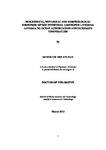Biochemical, metabolic and morphological responses of the intertidal gastropod Littorina littorea to ocean acidification and increase temperature
| dc.contributor.supervisor | Rundle, Simon D. | |
| dc.contributor.author | Melatunan, Sedercor | |
| dc.contributor.other | Faculty of Science and Engineering | en_US |
| dc.date.accessioned | 2012-05-24T08:57:09Z | |
| dc.date.available | 2012-05-24T08:57:09Z | |
| dc.date.issued | 2012 | |
| dc.date.issued | 2012 | |
| dc.identifier | 10178433 | en_US |
| dc.identifier.uri | http://hdl.handle.net/10026.1/1009 | |
| dc.description | Chapter 2 of the thesis has been published | en_US |
| dc.description.abstract |
Future changes to the pH and temperature of the oceans are predicted to impact the biodiversity of marine ecosystems, particularly those animals that rely on the process of calcification. The marine intertidal gastropod Littorina littorea can be used as a model of intertidal organism for investigating the effects of ocean acidification and high temperature, alone and in combination because its ability to be quickly adapt against environmental stressor. In the first study a single species population of L. littorea was used to test for physiological and biochemical effects underpinning organismal responses to climate change and ocean acidification. Compared with control conditions, snails decreased metabolic rates by 31% in response to elevated pCO2 while by 15% in response to combined pCO2 and temperature. Decreased metabolic rates were associated with metabolic depression, a strategy to match oxygen demand and availability, and an increase in end-product metabolites in the tissue under acidified treatments, indicating an increased reliance on anaerobic metabolism. This study also showed that anthropogenic alteration of CO2 and temperature may also lead to plastic responses, a fundamental mechanism of many marine gastropods to cope environmental variability. At low pH and elevated temperature in isolation or combined showing lower shell growth than individuals kept under control conditions. Percentage change in shell length and thicknesses was also lower under acidified and temperature in isolation or combined than control condition, making shells were more globular and desiccation rates were higher. Further studies to broader latitudinal ranges for six populations of L. littorea showed that shell growth decreased in all six populations under elevated pCO2 compared to control snails particularly those at range edges. Elevated pCO2 also affected to the reduction of shell length and width that causing shell aspect ratio to increase across latitudinal gradients except individuals from Millport, UK. Percentage changes of aperture width and aperture area were also decrease under elevated pCO2 with greater reduction of aperture area were found at populations in the mid-ranges which is assumed this response might be linked to local adaptation of the individual to microclimatic conditions. This study also showed that metabolic rates were negatively affected by high pCO2 and show non-linear trend across latitudinal gradients in compared to individual kept under normal pCO2 conditions. Metabolomic analysis showed that two northern populations of Trondheim and TromsØ were distinct from other populations when exposed to low temperature (15 °C) with elevated pCO2 due to, in part, high concentrations of thymine, uracil, valine and lysine. A similar separation also occurred under medium (25 °C) and high (35 °C) temperature exposure in which one of northern population (Trondheim) was distinct from other populations and had lower concentrations of alanine, betaine and taurine while higher of valine. These results suggest that populations at northern latitudes may apply different ionic transport mechanisms under elevated pCO2 and elevated temperatures and those populations are likely to vary in terms of their physiological responses to this environmental challenge. | en_US |
| dc.description.sponsorship | Directorate General of Higher Education, Ministry of National Education and Culture of the Republic of Indonesia | en_US |
| dc.language.iso | en | en_US |
| dc.publisher | University of Plymouth | en_US |
| dc.subject | Ocean Acidification | en_US |
| dc.subject | Climate Change | en_US |
| dc.subject | Biochemical, metabolic and morphological | en_US |
| dc.subject | Ecophysiology | en_US |
| dc.title | Biochemical, metabolic and morphological responses of the intertidal gastropod Littorina littorea to ocean acidification and increase temperature | en_US |
| dc.type | Thesis | |
| dc.identifier.doi | http://dx.doi.org/10.24382/3645 |
Files in this item
This item appears in the following Collection(s)
-
01 Research Theses Main Collection
Research Theses Main


